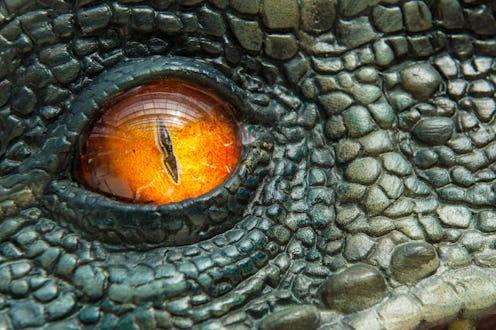News
Dinosaurs Could Be Real, And It's Not OK
Everyone has had this nightmare: You wake up in the morning, stretch, yawn, and slowly turn to the window to greet the day — when you see there is one giant Tyrannosaurus Rex eye staring through the window. What? No one else has had this bone-chilling, terrifying recurring death-dream? Oh, well. Never mind, then. No matter whether they turn up as unwelcome night terrors, dinos have been on the minds of many moviegoers these days, thanks to the box office hit Jurassic World . And though it's fun to watch Chris Pratt scramble for his life in the wake of giant lizard-beings, it brings up a real-life fear, people. So, can scientists make real dinosaurs one day?
Sorry, wait one minute — I, a matter-of-fact, rational journalist, had to take time to pass out at the mere mention of that hypothetical question. But let's dive deep into the validity of using science to make little, tiny, screeching baby dinosaurs that turn into blood-thirsty raptors that chase us around kitchens and trap us under appliances.
What have scientists actually done in the way of making our film fiction become actual reality where we all hide in trees from life-threatening predators? According to TIP News, the geniuses in the lab coats think it's a good idea to play around with chemicals that could create little raptor-murderers and are actually making headway on this project.
Jack Horner, a professor of paleontology at Montana University and an adviser on the Jurassic Park films, told TIP that dinosaur's "ancestral DNA is still present." He said there aren't any barriers to resurrecting the precious predators from their extinct graves. In 2003, Horner and his students happened upon a discovery that shocked them and, of course, led them to believe in their apparent dreams of a horrific dinosaur-laden future.
One of Horner's students, paleontologist Mary Schweitzer and her research assistant discovered blood vessels inside a fossilized dinosaur bone. This unsuspected soft tissue gave Horner and his team proof that they could, indeed, collect and salvage DNA from million-year-old bones.
TPI reported that Horner and his team studied the features of birds in order to recreate these structures to model after dinosaurs. But no fear, right? No one has actually tried to clone an animal larger than a lab rat, right? No. False.
Science Daily reported in 2003 that researcher Duane Kramer at Texas A&M University had success cloning a white-tailed deer. Oh, but that was a long time ago, right? There haven't been any recent developments, right? Again. Untrue. This chicken casually grew the face of a dinosaur in an experiment by Yale and Harvard researchers to recreate a chicken embryo with a dinosaur-like beak and snout. Things are happening. Nightmares are coming. And this is too much.
Images: Giphy (3)
